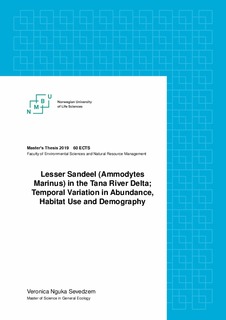| dc.contributor.advisor | Haugen, Thrond Oddvar | |
| dc.contributor.advisor | Colman, Jonathan Edward | |
| dc.contributor.author | Sevedzem, Veronica Nguka | |
| dc.coverage.spatial | Norway, Finnmark, Tana | nb_NO |
| dc.date.accessioned | 2019-11-20T15:09:31Z | |
| dc.date.available | 2019-11-20T15:09:31Z | |
| dc.date.issued | 2019 | |
| dc.identifier.uri | http://hdl.handle.net/11250/2629597 | |
| dc.description | Samples of sandeels are and substrates were collected using a van Veen grab during nine sampling rounds in 2017 and 2018 covering all seasons and representative habitat of the Tana Estuary. Sub-samples of sandeels were age determined and all individual were counted and length measured. During spawning season degree of maturity was assigned. Substrate grain sizes were assess in situ. Habitat preference with respect to depth and substrate grain size estimated using zero inflated models and adehabitatHS - packages in R. | nb_NO |
| dc.description.abstract | Lesser sandeel (Ammodytes marinus, Raitt, 1934, sandeel for short) is a keystone species of the Barents Sea ecosystem. However, little is known about the distribution of this species in the Tana fjord or Tana river delta system. This study examines the physical characteristics of sandeel habitat in an attempt to predictand its habitat use and preferences, as well as age and size at maturation, spawning season and individual variation in habitat use. The characteristics of sandeel habitat use were described from grab sampling and depth recordings.
Sandeels avoided areas with substrate content <0.1 mm. Zero-inflated Poisson analyses of the variation in sandeel density across different habitat types revealed abundance to peak at depths between 10 and 20 m for substrate grain sizes in the 1-5 mm range. Sandeel abundance in bottom habitats in the Tana delta, with high abundance in the spring and winter and less in the summer. Habitat preference analyses showed non-random grain-size selection amongst the sandeel individuals with the highest preference for grain-sizes around 0.7 mm and 20 mm. Analyses of the maturation pattern yielded 50 % maturation probability at length 120.8±1.9 mm and at age 0.92±0.05 years) were major determinants for maturation probability. The analysis of sandeel habitat use showed matching characteristics with the depths and habitat characteristics of the area planned for dredging. To maintain sandeel habitat in light of the planned dredging in their optimal habitat, some recommendation have been proposed as well as additional studies that ought to include echo sounding to gain further knowledge on the open water habitat use of this key species. | nb_NO |
| dc.language.iso | eng | nb_NO |
| dc.publisher | Norwegian University of Life Sciences, Ås | nb_NO |
| dc.rights | Attribution-NonCommercial-NoDerivatives 4.0 Internasjonal | * |
| dc.rights.uri | http://creativecommons.org/licenses/by-nc-nd/4.0/deed.no | * |
| dc.title | Lesser sandeel (Ammodytes marinus) in the Tana river delta : temporal variation in abundance, habitat use and demography | nb_NO |
| dc.type | Master thesis | nb_NO |
| dc.description.version | submittedVersion | nb_NO |
| dc.description.localcode | M-ECOL | nb_NO |

